
Frank Owen Gehry is a Canadian-born American architect and designer. A number of his buildings, including his private residence in Santa Monica, California, have become world-renowned attractions.
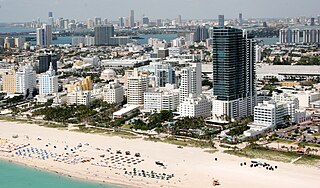
Miami Beach is a coastal resort city in Miami-Dade County, Florida, United States. It is part of the Miami metropolitan area of South Florida. The municipality is located on natural and human-made barrier islands between the Atlantic Ocean and Biscayne Bay, the latter of which separates the Beach from the mainland city of Miami. The neighborhood of South Beach, comprising the southernmost 2.5 sq mi (6.5 km2) of Miami Beach, along with Downtown Miami and the PortMiami, collectively form the commercial center of South Florida. Miami Beach's population is 82,890 according to the 2020 census. It has been one of America's preeminent beach resorts since the early 20th century.
The Los Angeles Philharmonic is an American orchestra based in Los Angeles, California. Colloquially referred to as the LA Phil, the orchestra has a regular season of concerts from October through June at the Walt Disney Concert Hall, and a summer season at the Hollywood Bowl from July through September. Gustavo Dudamel is the current music director, Esa-Pekka Salonen is conductor laureate, Zubin Mehta is conductor emeritus, and Susanna Mälkki is principal guest conductor. John Adams is the orchestra's current composer-in-residence.

The Walt Disney Concert Hall at 111 South Grand Avenue in downtown Los Angeles, California, is the fourth hall of the Los Angeles Music Center and was designed by Frank Gehry. It was opened on October 23, 2003. Bounded by Hope Street, Grand Avenue, and 1st and 2nd Streets, it seats 2,265 people and serves, among other purposes, as the home of the Los Angeles Philharmonic orchestra and the Los Angeles Master Chorale. The hall is a compromise between a vineyard-style seating configuration, like the Berliner Philharmonie by Hans Scharoun, and a classical shoebox design like the Vienna Musikverein or the Boston Symphony Hall.

Michael Tilson Thomas is an American conductor, pianist and composer. He is Artistic Director Laureate of the New World Symphony, an American orchestral academy in Miami Beach, Florida, Music Director Laureate of the San Francisco Symphony, and Conductor Laureate of the London Symphony Orchestra. He gave his last performance with the San Francisco Symphony in January 2024 while fighting brain cancer.
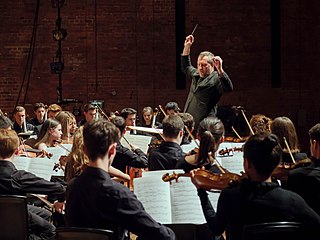
Thomas Joseph Edmund Adès is a British composer, pianist and conductor. Five compositions by Adès received votes in the 2017 Classic Voice poll of the greatest works of art music since 2000: The Tempest (2004), Violin Concerto (2005), Tevot (2007), In Seven Days (2008), and Polaris (2010).
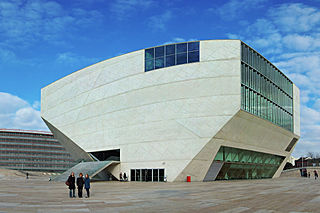
The Casa da Música is a concert hall in Porto, Portugal. It was designed by architect Rem Koolhaas and opened in 2005.
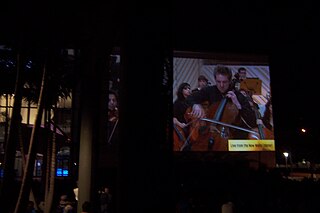
The New World Symphony is an American orchestral academy based in Miami Beach, Florida. Established in 1987, the organization is a training ensemble for young musicians in preparation for professional careers in classical music. Since 2011, the New World Symphony has its headquarters in the New World Center.

The Toledo Museum of Art is an internationally known art museum located in the Old West End neighborhood of Toledo, Ohio. It houses a collection of more than 30,000 objects. With 45 galleries, it covers 280,000 square feet and is currently in the midst of a massive multiyear expansion plan to its 40-acre campus. The museum was founded by Toledo glassmaker Edward Drummond Libbey in 1901, and moved to its current location, a Greek revival building designed by Edward B. Green and Harry W. Wachter, in 1912. The main building was expanded twice, in the 1920s and 1930s. Other buildings were added in the 1990s and 2006. The museum's main building consists of 4 1/2 acres of floor space on two levels. Features include fifteen classroom studios, a 1,750-seat Peristyle concert hall, a 176-seat lecture hall, a café and gift shop. The museum averages some 380,000 visitors per year and, in 2010, was voted America's favorite museum by the readers of the visual arts website Modern Art Notes.

Contemporary architecture is the architecture of the 21st century. No single style is dominant. Contemporary architects work in several different styles, from postmodernism, high-tech architecture and new references and interpretations of traditional architecture to highly conceptual forms and designs, resembling sculpture on an enormous scale. Some of these styles and approaches make use of very advanced technology and modern building materials, such as tube structures which allow construction of buildings that are taller, lighter and stronger than those in the 20th century, while others prioritize the use of natural and ecological materials like stone, wood and lime. One technology that is common to all forms of contemporary architecture is the use of new techniques of computer-aided design, which allow buildings to be designed and modeled on computers in three dimensions, and constructed with more precision and speed.

The Colburn School is a private performing arts school in Los Angeles with a focus on music and dance. It consists of four divisions: the Conservatory of Music, Music Academy, Community School of Performing Arts and the Trudl Zipper Dance Institute. Founded in 1950, the school is named after its principal benefactor, Richard D. Colburn.

Grant Mudford, is an Australian photographer.
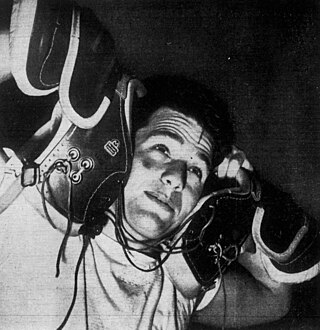
Daniel Leonard Dworsky was an American architect who was a longstanding member of the American Institute of Architects College of Fellows. Among other works, Dworsky designed Crisler Arena, the basketball arena at the University of Michigan named for Dworsky's former football coach, Fritz Crisler. Other professional highlights include designing Drake Stadium at UCLA, the Federal Reserve Bank in Los Angeles and the Block M seating arrangement at Michigan Stadium. He is also known for a controversy with Frank Gehry over the Walt Disney Concert Hall.
The YouTube Symphony Orchestra(YTSO) is an orchestra assembled by open auditions hosted by YouTube, the London Symphony Orchestra and several other worldwide partners. Launched on December 1, 2008, it is the first online collaborative orchestra.
The year 2011 in architecture involved some significant architectural events and new buildings.
Grand Avenue is a major north–south thoroughfare in Los Angeles, California. Primarily located in downtown's Bunker Hill, Financial, and South Park districts, the avenue features many of the area's most notable destinations, and also connects to City Hall via Grand Park.

The Lincoln Theatre on Lincoln Road in the South Beach neighborhood of Miami Beach, Florida was a movie theater and later a concert hall. It was designed in art deco style by noted cinema and theater designer Thomas W. Lamb and opened in 1936. It functioned as a cinema until the 1980s, then sat vacant for several years, then was used for performances of the New World Symphony, which bought it in 1990. The symphony carried out a multimillion-dollar renovation.
Polaris: Voyage for Orchestra is an orchestral composition by the British composer Thomas Adès. The work was co-commissioned by the New World Symphony under the direction of Michael Tilson Thomas for the opening of the New World Center. The New World Symphony was joined in commission by the Royal Concertgebouw Orchestra, the New York Philharmonic, the Calouste Gulbenkian Foundation, the Barbican Centre, the Los Angeles Philharmonic, and the San Francisco Symphony. It was given its world premiere by Michael Tilson Thomas and the New World Symphony at the New World Center in Miami Beach on January 26, 2011.

Youth Orchestra Los Angeles (YOLA) is the Los Angeles Philharmonic's initiative to establish youth orchestra programs in underprivileged communities throughout Los Angeles. Modeled on Venezuela's El Sistema, a program which brings classical music education to children from low-income communities, YOLA provides free instruments, music training, and academic support to nearly 800 students age 6-18. A "social project first and artistic project second", 100% of YOLA's 2016 graduating class completed high school, and 90% went on to college.



















